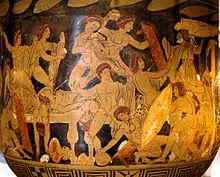In Greek mythology, Theoclymenus (/ˌθiəˈklɪmɪnəs/; Ancient Greek: Θεοκλύμενος) was a prophet from Argos.
Family[edit]
Theoclymenus was the son of Polypheides and Aechme, daughter of Haemon, and brother of Harmonides.[1] In some accounts, his parents were Thestor and possibly Polymele,[2] and thus, the brother of Leucippe, Theonoe and Calchas.[3]
Mythology[edit]

In the Odyssey, he escaped from Argos after killing one of his relatives. He fled to Pylos and sought refuge aboard the ship of Telemachus, who had come to inquire about the fate of his father, Odysseus. Telemachus obliged, and Theoclymenus accompanied him back to Ithaca. There, Theoclymenus interpreted the auspices of the birds, predicting that Telemachus would become head of the royal house of Ithaca. He also prophesied that Odysseus was already in Ithaca, disguised and watching as events unfolded. When he told Penelope of these signs, she did not believe him. Later, at dinner, he had a vision of the death of the suitors, but they laughed at his predictions, not knowing they would be killed that night.[4]
Theoclymenos of Egypt[edit]
Theoclymenos is also the name of the king of Egypt in Euripides' play Helen.
Notes[edit]
References[edit]
- Gaius Julius Hyginus, Fabulae from The Myths of Hyginus translated and edited by Mary Grant. University of Kansas Publications in Humanistic Studies. Online version at the Topos Text Project.
Well, that’s interesting to know that Psilotum nudum are known as whisk ferns. Psilotum nudum is the commoner species of the two. While the P. flaccidum is a rare species and is found in the tropical islands. Both the species are usually epiphytic in habit and grow upon tree ferns. These species may also be terrestrial and grow in humus or in the crevices of the rocks.
View the detailed Guide of Psilotum nudum: Detailed Study Of Psilotum Nudum (Whisk Fern), Classification, Anatomy, Reproduction